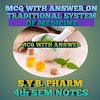T.Y B. PHARM SEM - V
PHARMACOGNOSY & PHYTOCHEMISTRY – II
EXPERIMENT NO: 12
AIM: To Study Thin Layer Chromatography (TLC) of Ashwagandha Extract.
REFERENCE:
1. Dr. Anup K. Chakraborty, Sushma M. Rathod. “Practical in pharmacognosy & phytochemistry – II. Edition 2019, published by S. Vikas & company (Medical publisher), Page no. 55.
REQUIREMENTS:
Apparatus: TLC
plates, Glass chamber, Iodine chamber, Hot air oven, Beaker, Capillary etc.
Chemical: Cinchona powder, Chloroform, Methanol,
PROCEDURE:
Preparation of extract:
Powdered sample extracted with methanol. The extract concentrated and residue
dissolved in methanol.
Adsorbent (Stationary
Phase): Make 15 g silica gel slurry with 20 ml of distilled
water. The plates are coated with slurry of silica gel to a width of 0.4mm,
allowed to dry at room temperature, activated oven at 120°C for 20 min.
Solvent system (Mobile
Phase): The solvent system, Chloroform, Methanol (09:01) is
poured in the TLC chamber to a depth of 3cm and allow to saturate. The chamber
is lined with filter paper on three sides to maintain equilibrium of mobile
phase
Application of spots:
The above sample applied as two spot on each plate with the help of capillary.
Development of chromatogram: The chromatogram is established by ascending technique, allowing solvent system to reach a height of 10 cm. The plates are withdrawn from the chamber, air-dried and Spray with Anisaldehyde sulphuric acid reagents and air dry. calculate Rf Value.
RESULT: The TLC of Ashwagandha extract was performed and the Rf value was found to be…………………….













0 Comments
Please do not enter any spam link in the comment box.